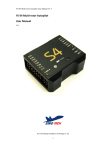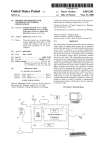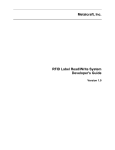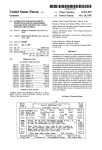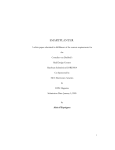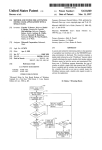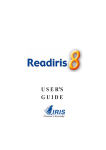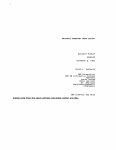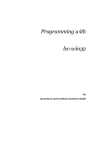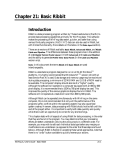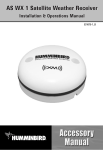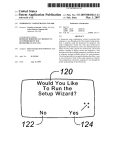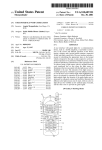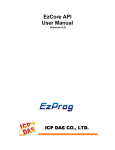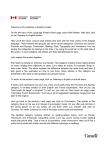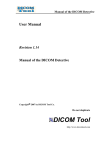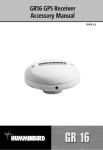Download llllllllllllllllllllllllllllllllllllllllllllllllllllllllllllllIllIllllllll
Transcript
llllllllllllllllllllllllllllllllllllllllllllllllllllllllllllllIllIllllllll
US005533180A
United States Patent [191
[11]
Patent Number:
5,533,180
Zhou et a1.
[45]
Date of Patent:
Jul. 2, 1996
[54] METHOD OF MANIPULATHV G FONTS
CONTAINING LARGE NUMBERS OF
CHARACTERS
1992-93 Eurasian Software Catalog, Pac?c Rim Connec—
[75] Inventors: Frank H. Zhou; Qin-Mo Wang, both
of Vancouver, Canada
tions, Inc., Burlingame, CA.
“Topfonts Applications”, 1991 catalog of Top Computech
Co. Ltd., Vancouver, B.C., Canada.
“TopFonts & TopBridge User Manual”, 1993 publication of
Taisim International Limited, Hong Kong.
[73] Assignee: Top Computech Co. Ltd., Canada
“TopFonts For Windows”, undated user manual.
“TopFonts & TopBridge” user manual for PageMaker, Ven
tura, CorelDRAW!, . . . , undated manual of Top Computech
[21] Appl. No.: 224,585
[22] Filed:
Apr. 7, 1994
[51]
[52]
[58]
Co. Ltd., Vancouver, B.C., Canada.
Primary Examiner—Heather R. Hemdon
Assistant Examiner—]oseph R. Burwell
Attorney, Agent, or Firm~Oyen Wiggs Green & Mutala
Int. Cl.6 .................................................... .. G06F 15/00
U.S. Cl. ........................................... .. 395/150; 395/155
Field of Search ................................... .. 395/150, 151,
[57]
395/156-158, 160, 161; 345/141, 143,
A method of enabling a computer user to manipulate, as one
192—195
[56]
ABSTRACT
font, an arbitrary number of special characters exceeding the
256 characters which single byte font schemes can represent
References Cited
in one font. The invention takes advantage of the user
PUBLICATIONS
activatable font management capabilities built into popular
application programs, such as a mechanism for switching
between different standard character fonts; and, a font dis
play mechanism for enabling the user to monitor the font
switching procedure. The special characters are divided into
font segments, with each segment containing a number “X”
(less than 256) characters. The segments are stored for
subsequent retrieval. Each character input by the user is
scanned to determine whether it is one of the special
characters. Non-special characters are passed without fur
ther action. If a special character is detected, the stored font
segment containing that character is identi?ed to see if it is
the font currently in use by the program. If so, control passes
Cameron, “ComputerLand introduces Chinese language
computing”, Newsbytes, Jun. 7, 1993.
“Chinese Star”, 1993 brochure of Dorak Intl. Inc., San
Gabriel, CA.
“Dorak”, undated brochure of Dorak lntl. Inc., San Gabriel,
CA [Chinese language—no translation available].
“Chinese Star for Windows”, undated brochure of Dorak
lntl. Inc., San Gabriel, CA [Chinese language-no transla
tion available].
“HanWenDao”, undated brochure of Sinosoft Systems Ltd.,
Vancouver, B.C., Canada.
“Our Computer Player” newspaper, 18 Feb. 1994, pp. 4l—42
including p. 41 Chinese language article respecting font
manipulation software and advertisements (pp. 41 & 42) of
TwinBridge and HanWenDao products.
“Top Solutions For Chinese Desktop Publishing”, undated
brochure of Top Computech Co., Ltd., Vancouver, B.C.,
to the application program. Otherwise, the font switching
mechanism is activated to select the font segment containing
the input character as the current font. As this is done,
activation of the font display mechanism is suppressed so
that the font switching occurs in a manner transparent to the
user. Control then passes to the application program.
Canada.
Undated poster of Top Computech Co. Ltd., Vancouver,
B.C., Canada.
7 Claims, 10 Drawing Sheets
[7%
34
CallCn
is
byte
I
Li
Vmual Font
NIJ!
1
Real Fun!
Anal
I
US. Patent
Jul. 2, 1996
Sheet 1 0f 10
5,533,180
SE.<
2EP6Et<:9“.
625
wE>
Emogx
wmixvtsg
+
F
3.
9
5
“
.
xwc0oz :su
.625
US. Patent
Jul. 2, 1996
Virtual Font
Sheet 3 0f 10
Real Font I
5,533,180
1 <--————-—-—> 256
Aria!
=
Aria]
A
B
Courier
=
Courier
A
B
y
2 ?
z
Fang-Song real font-segment 1
Fang-Song real font-segment 2
w
m
4_4
3Q ,
L1
f
Fang-Song
Fang-Songrealfont-segmentn
_
Q
_ ‘if
Hei-Ti real font-segmentl
5}
i
i
Hei-Tirealfont-segmentZ
3
53?,
E i T
Hei-Ti real font-segmentn
E
if
g2 . u
Song-Ti real font-segmentl
i 5}
gig
i 2' g I
Song-Tirealfont-segmentZ
I g 5 52
155
T
Song-Ti real font-segmentn
' g
?
Li :
Hei-Ti
Song-Ti
Figure 3
'5]
US. Patent
Jul. 2, 1996
Sheet 5 0f 10
fuF/ag ::
MF_STRING
5,533,180
Windows,
No
'
AppendMenu
?
Yes
IpNew/tem ==
Name of real font
segments
Yes
Receive all real
font segments of
the virtual font
Yes
Pass the name of
the Chinese virtual
font and call
Windows’
AppendMenu
Figure 5 (a)
'
N°__""W
Call M?ndows
AppendMenu
U.S. Patent
Jul. 2, 1996
Sheet 6 0f 10
hwnd's parent is
Wn'te
5,533,180
Call Windows’
No
I
SendMessage
N°
"
SendMessage
7
Yes
uMs ==
LB__ADDSTRING
1)
Yes
Receive all real
font segments of
the virtual font
Yes
L
Pass the name of
the Chinese virtual
font and call
Windows’
SendMessage
Figure 5 (b)
Call Windows‘
US. Patent
Jul. 2, 1996
Virtual Font
Aria!
Courier
=
Sheet 7 0f 10
Real Font
Arial
5,533,180
1 <———---———> 256
_
Courier
- - -
A
B
A
B
Fang-Songreal font-segmentl
Fang-Song real font-segmentZ
#71
' ' '
y
z
y
Z
i
i
% E
55g
7d‘;
Y
i
i
E
{E
T
?
[,1
Fang-Song
F ang-Song real font-segment n
Hei-Ti real font-segmentl
Hei-Tireal font-segmentZ
?
Hei-Tirealfont-segmentn
i E
Hei-Ti
Figure 6
if
' ' '
US. Patent
Jul. 2, 1996
Sheet 8 of 10
Head = Beginning of highlight
Tail = End of highlight
i
Cancel highlight
C Loop from Head to Tail )1-—
Highlight one Chinese
character
L
Get font information
L
Calculate new font information
i
Change font
L
Move to next character
is this the end
of the highlight
’?
Yes
Figure 7
5,533,180
US. Patent
Jul. 2, 1996
Sheet 9 of 10
5,533,180
w2:9“.
Ewomuw
23m00965240:“ g8E552a:203
wmluV vmws
amawuw
@3&9.
mm
US. Patent
Jul. 2, 1996
Sheet 10 0f 10
5,533,180
wE9>eo2UEl>
m0.59m
Emonmw
3m29632w0DAm: as:2EEE=250?
so?Il AV .
:mm
.%:MN
.;<
5,533,180
1
2
METHOD OF MANIPULATING FONTS
CONTAINING LARGE NUMBERS OF
CHARACTERS
SUMMARY or THE INVENTION
In accordance with the preferred embodiment, the inven
tion provides a method of interfacing between a computer
user and a computer application program to enable the user
FIELD OF THE INVENTION
to manipulate, as one font, an arbitrary number of special
characters exceeding the 256 standard characters which the
This application pertains to computer manipulation of
program can represent in one font. The invention takes
font character sets in a manner which gives computer users
advantage of the user-activatable font management capabili
the convenience of working with a single font containing
potentially thousands of characters (such as Chinese char
acters) while the computer works with multiple font sets,
ties built into popular application programs, such as a means
each containing only 256 characters.
BACKGROUND OF THE INVENTION
15
Computers were originally designed to handle natural
are stored for subsequent retrieval. As the user inputs
languages (principally English) which utilize comparatively
characters, the invention determines whether the input char
small numbers of characters. For example, the set of char
acter is one of the special characters or not. If the input
acters commonly found on English language keyboards
comprising the upper case letters A-Z, lower case letters
a—z, digits 0—9, plus a few punctuation marks and other
20
special characters normally su?ice to enable English speak
ers to interact with computers. A “font” is a complete group
of such characters presented in the same style (i.e. typeface)
25
and size.
Western computer designers have standardized fonts to
consist of 256 characters per font. This presents a problem
to users who wish to interact with computers in other
means is suppressed so that the font switching is transparent
to the user. Control then passes to the application program.
In some cases the font switching display means may be a
pull down menu listing both the standard character fonts and
the stored font segments, in which case the font switching
A single eight-bit “byte” of information can uniquely
represent any one of the possible 256 different characters in
a conventional English character font. Since computers can
means is activated by the user selecting one of the listed
conveniently manipulate information in bytes, this largely
explains why Western designers elected to restrict them
40
characters). Chinese software developers have accordingly
developed “dual-byte” font schemes to enable users to
interact with computers in Chinese.
Font-handling technology is fundamental to a computer
program’s ability to interact with a user in the input, display,
printing of other use of characters. Western computer soft
ware, such as that designed for use with the popular
Microsoft® WindowsTM environment, relies upon single
byte fonts consisting of only 256 characters per font. This
renders Chinese dual-byte software incompatible with the
fonts according to its position in the list. In such case, the
invention creates and stores a table identifying the position
of each of the standard character fonts and each of the stored
font segments in the list. This facilitates selection, as the
current font, of the font segment containing the input char
acter by examining the table to determine that segment’s
position in the list. The list is then opened and the font
(Two bytes, consisting of 16 bits, can uniquely represent any
one of 65,536 possible different characters, which is more
than adequate to cover the complete range of Chinese
font, the font switching means is activated to select the font
As this is done, activation of the font switching display
inadequate to represent a useful range of Chinese characters.
selves to 256 characters per font. However, two bytes are
character is not one of the special characters, then control
passes to the application program. If the input character is
one of the special characters, the invention determines which
of the stored font segments contains the input character, and
determines which font is currently in use by the program. If
the font segment containing the input character is the current
font, then control passes to the application program. If the
font segment containing the input character is not the current
segment containing the input character as the current font.
languages having many more characters than English. For
example, the Chinese language has over 15,000 characters in
contemporary use, with about 3,000 of those being in
everyday use. Fonts restricted to 256 characters are clearly
required to uniquely represent any one of the possible
different characters in a single font of Chinese characters.
for switching between different standard character fonts;
and, a font switching display means for enabling the user to
monitor the font switching procedure.
In its most basic form, the invention divides the special
characters into font segments, with each segment containing
a number “X” (less than 256) characters. The font segments
occupying the deterrrrined position selected.
45
In other cases the font switching display means may be a
user-activated pop-up dialog box identifying the standard
character fonts and the stored font segments. In such case,
50
the invention selects the font segment containing the input
character as the current font by passing to the application
program a parameter representative of that font segment,
while suppressing activation of the pop-up dialog box.
BRIEF DESCRIPTION OF THE DRAWINGS
55
Chinese users the bene?ts of that environment and prevent
FIG. 1(a) is a block diagram illustrating the prior art
technique used to input standard single-byte characters into
ing them from using (in their preferred Chinese language)
the many sophisticated application programs developed for
ronment.
Microsoft® WindowsTM environment, potentially denying
application software via the Microsoft® WindowsTM envi
that environment.
FIG. 1(b) is a block diagram illustrating the technique
60
used by the present invention to input Chinese characters
The present invention solves this problem, in a manner
which is completely transparent to the computer user, by
converting (or mapping) each dual-byte character font into
a plurality of single-byte character font segments compatible
with the Microsoft®Windows'1M environment. This facili 65
tates direct input of Chinese characters into any software
which utilizes single-byte font technology.
into application software via the Microsoft® WindowsTM
environment.
FIG. 2 is a How chart illustrating the sequence of steps
used by the present invention to input Chinese characters
into application software via the Microsoft® WindowsTM
environment.
5,533,180
3
4
FIG. 3 is a chart illustrating various fonts consisting of
256 characters each and indicating the invention’s presen
tation, to the user, of a single “virtua” font potentially
containing many thousands of characters, while the com
puter works with a multiplicity of “real” font segments, each
tions are a well-documented aspect of the WindowsTM
application programmer interface (“API”) and those skilled
in the art are very familiar with their use, so they need not
be described in great detail here. [Further details may be
obtained from the Microsoft® WindowsTM Visual C++ tech
nical documentation, the Microsoft® WindowsTM System
Developer’s Kit (“SDK”) and other similar technical docu
mentation familiar to those skilled in the art] Basically, as
containing only 256 characters.
FIG. 4 is a ?ow chart illustrating the sequence of steps
used by the present invention to switch fonts in a manner
transparent to the user by suppressing display of the dialog
boxes used by some application software to enable user
l0
controlled font switching, while mimicking the action of
such dialog boxes to cause the software to switch fonts.
FIG. 5(a) is a ?ow chart illustrating the sequence of steps
used by the present invention to display to the user, on a pull
down menu listing available fonts, only the virtual font
depicted in FIG. 1(a), Microsoft® Windows'rM ordinarily
directly receives keyboard (or mouse) input and passes it to
the underlying application software (which may be one of
many popular applications such as MS-Write'YM, QuarkX
PressTM, PageMakerTM, etc.).
15
As depicted in FIG. 1(b), the invention uses Hook func
tions to trap input events triggered by user activation of the
keyboard or mouse; and, to redirect and/or generate sub
names, not the names of the many real font segments which
stitute events to the system event queue. When program
collectively comprise each virtual font. FIG. 5(b) is a ?ow
chart illustrating the sequence of steps used by the present
invention to display to the user, in a dialog box listing
code conforming to the invention is launched under the
Microsoft® WindowsTM environment, it intercepts such
available fonts, only the virtual font names, not the names of
sequences and keyboard events through the use of Hook
functions.
input events and (if appropriate) substitutes key-stroke
the many real font segments which collectively comprise
each virtual font.
FIG. 6 is a chart illustrating construction of virtual fonts
with each Chinese character maintaining the same position
in the same numbered real font segment.
FIG. 7 is a ?owchart illustrating the procedure used to
Use of Hook Functions by the Input System
25
this a valid representation of a Chinese character?” If the
change text passages from one virtual font to another, even
if the passages consist of characters drawn from different
real font segments.
FIGS. 8 and 9 respectively depict the manner in which
character codes are mapped from the “GB” or “BIG—5” code
schemes to virtual fonts consisting of a multiplicity of real
font segments, each such segment containing 256 characters
compatible with Western computer software.
answer is “No”, then the input (ASCII) key-stroke
sequences are passed via Microsoft® WindowsTM to the
30
does not de?ne a valid Chinese character, the invention
35
The main input problem involves homonyms (i.e. differ
ent words with different meanings, but sharing the same
40
users to access thousands of different Chinese characters
using the standard 101 key “QWERTY” keyboard familiar
to English users. The input system “traps” keystroke
dual-byte representation. The dual-byte representation is
the input keystroke sequence is converted into the dual-byte
representation of the Chinese character de?ned by that input
sequence.
Overview
sequences to select the desired Chinese character and its
particular application software with which the user happens
to be interacting. In other words, if the input key sequence
ignores that sequence and passes it on without modi?cation.
But, if the answer to the foregoing question is “Yes”, then
DETAILED DESCRIPTION OF THE
PREFERRED EMBODIMENT
An input system is provided to enable Chinese speaking
Hook functions are used to trap keyboard events and to
determine whether the input key sequence is a valid repre
sentation of a Chinese character. Speci?cally, the test is: “is
spelling for each valid keystroke sequence). For example,
the Pin-Yin Chinese character “ma” has several homonyms,
including the Chinese equivalents of the words “mother”
and “horse”. The conventionally adopted solution is to
present the user with a list of homonym characters on a
menu bar displayed at the bottom of the screen, with a
45
then converted to a single-byte “virtual font” representation.
unique code (typically one of the digits 0-9) adjacent to each
homonym. Up to ten homonym characters are normally
displayed at once, and a facility is provided to enable the
The conversion is done in a manner which is transparent
user to quickly display any additional homonyms. The user
to both the user and to the software application with which
selects the desired character by keying the appropriate
the user interacts. That is, if the user inspects the list of 50 unique homonym code on the keyboard. For example, for
available fonts, only one virtual font name such as “Fang
the character “ma”, the user might type the code 1 number
Song” or “Kai-Ti” will be seen for each Chinese character
for “mother”; 2 for “horse” and so on. In practice, a variety
font, along with any available English fonts such as “Times
Roman” or “Arial”. However, the underlying application
software “sees”, for each Chinese character virtual font,
many separate “real” fonts, each consisting of only 256
characters. Thus, the user has the convenience of selecting,
55
and need not be further elaborated here.
via appropriate input keystroke sequences, any virtual font
character, without having to worry about which of the many
real font segments contains that character and manually
switching to that font segment. The necessary lookup and
switching functions are performed by the invention.
of techniques are used in discriminating between hom
onyms, depending upon the particular input method in use.
These techniques are well known to those skilled in the art,
60
FIG. 2 illustrates the input procedure in more detail. Input
box 10, decision box 12 and output box 14 depict the
sequence of events previously described with respect the
PIG. 1(b) for non-Chinese character input. Decision box 16
and its ?ve output paths labelled 1-5 represent the action
taken for Chinese input-related keyboard events, as follows:
1. Path 1 is taken if a valid (complete or incomplete) Chinese
Input System
input Chinese characters to application programs operating
key-stroke sequence has been received. If the keyboard
input buffer is full, control passes to output box 18 for
conversion of the input sequence to the appropriate Chi
under the Microsoft® WindowsTM environment. Such func
nese dual byte code as hereinafter described.
The invention employs Windows “Hook” functions to
65
5,533,180
5
6
2. Path 2 is taken to enable user selection of a desired
earlier, is the incompatibility of dual-byte Chinese character
font representations with single byte 256-character fonts
employed by Western software, particulary software
designed for the popular Microsoft® WindowsTM environ
Chinese homonym via numerical code, as aforesaid. Note
that the expected input here is a digit which can be
handled in conventional fashion by the Microsoft® Win
dowsTM environment.
ment.
The invention solves this problem by using “virtual
3. Path 3 is taken to enable user selection of additional lists
of Chinese homonyms, as aforesaid.
fonts”. Each virtual font corresponds to one actual Chinese
4. Path 4 is taken if the user strikes the backspace key to
indicate that the previously-typed keyboard character is to
Each virtual font is, transparently to the user, mapped to a
font containing perhaps 13,000 or more Chinese characters.
be ignored.
multiplicity of “real” font segments, each containing 256
5. Path 5 is taken if the user inputs a special “end of
characters. Each real font segment may contain up to 188
key-sequence” code—usually 0X20, whereupon control
Chinese characters (the remaining 68 characters being
reserved for digits, punctuation and other special symbols).
passes to output box 18 for conversion of the input
sequence to the appropriate Chinese dual byte code as
hereinafter described.
Thus, one virtual font containing 13,160 Chinese characters
would be mapped to 70 separate real-font segments (i.e.
70><188=13,160).
Mapping Double-byte Codes to Single-byte Real
Font Segments
As previously indicated, each virtual font comprises,
20
transparently to the user, a multiplicity of “real” font seg
ments, each containing 256 characters. The various virtual
fonts are established according to one of several different
double-byte character code schemes which have been
devised to meet the natural language needs of the Asian
25
markets. These schemes (sometimes called “inner codes”)
are still in a state of ?ux and it is unclear which will become
characters, there is a one-to-one correspondence between the
virtual and real fonts. But, in the case of a Chinese font
30
Currently popular Chinese inner codes schemes use 2
bytes to de?ne each character, although there are some
3-byte and even 4-byte code schemes in use. For all practical
purposes, however, there are only two dominant codes;
namely, the “BIG-5” code established in Taiwan and the
segments seen by the software. Note that, in the case of an
English font which can be completely represented in 256
the ultimately accepted “standar ”. Each scheme represents
a di?erent strategy for manipulating large numbers of char
acters as a single font.
FIG. 3 depicts a mixture of conventional 256 character
English fonts such as “Arial”, “Courier” and “Times
Roman” with Chinese fonts such as “Fang-Song”, “Hei—Ti”,
“Ti”, “1i”, “Wei” and “Kai-Ti”. The left column depicts the
virtual font names seen by the user upon inspection of the
font list via the font interface mechanism provided by the
particular application software. The table on the right
depicts, in each row, the actual 256-character real font
having potentially thousands of characters, there is a one
to-many correspondence between the virtual and real fonts.
That is, for each virtual Chinese font there are “n” real font
segments, each consisting of 256 characters comprising up
to 188 Chinese characters as aforesaid, where “n” is the
35
number of real font segments required to represent all
Chinese characters of interest.
“GB” (“Guojia Biaozhun” established in the People’s
Republic of China. Other codes in use include the “III”
Implementation of the Virtual Font Management
(Taiwan Institute for Information Industry) code (2 and 3
bytes) and the IBM 5550 code (2 bytes).
Scheme
FIGS. 8 and 9 respectively depict the manner in which
40
character codes are mapped from the “GB” or “BIG-5” code
schemes to virtual fonts consisting of a multiplicity of real
font segments, each such segment containing 25 6 characters
by mimicking font switching actions which are normally
done manually by the user, while suppressing the displays
that the user would see in manually activating them. The
compatible with western computer software. As illustrated,
the “GB” and “BIG-5” code schemes can each be repre
sented as a matrix of characters. For example, the “GB”
scheme can be represented as a matrix of 94 columns, each
having 92 rows of characters for a total of 8648 characters;
and, the “BIG-5” scheme can be represented as a matrix of
45
157 columns, each having FA (hexadecimal) rows of char
acters for a total of 39,250 characters. Using the formulae
50
result is that the user is unaware that a real font segment
change has taken place, while the underlying application has
made the appropriate font change. In other words, the
invention makes it appear to the application that the user has
changed from one real font segment to another, when in fact
the change is made automatically and transparently.
There are two way to do this, depending on the Graphical
User Interface (GUI) adopted by the application with which
shown in FIGS. 8 and 9 respectively, one may convert the
the user wishes to interact. Some applications use pull-down
menu lists to select fonts. Other applications use dialog
row-column matrix representation of any character from
either of the “GB” or “BIG-5” code schemes to establish the
1-of-256 character position and real font segment number
de?ning that character in a virtual font consisting of a
multiplicity of real font segments.
The invention switches between the various real font
segments comprising a single virtual Chinese character font
55
boxes to enable users to select fonts. In either case, the
invention mimics the font selection procedure.
Mimic Pull-Down Menu
Using well-documented aspects of the Windows'l'M appli
Virtual Font Management
cation programmer interface which are very familiar to those
The object of the invention is to make it as easy for a user
to select a Chinese font (typeface) as it is to select a
skilled in the art, the invention generates the WM_COM
MAND and wparm which are normally generated by manual
conventional 256-character English font. In other words,
selection of an item from a pull-down menu list. The
users may select a Chinese font such as “Fang-Song” or
“Kai-Ti” from a pull-down list of fonts in precisely the same
application responds to these messages as though they
65
originated from the user’s manual selection from the menu
way that English speakers select familiar English fonts such
bar, when in fact they are generated by the invention’s
as “Times Roman” or “Arial”. The problem, described
virtual font manager.
5,533,180
7
8
There are two problems here though. The ?rst problem is
that it is necessary to suppress display of the pull-down
menu. This is achieved by intercepting the change font
plicity of real font segments. Since each real font segment
command and suppressing display of the pull-down menu.
contains only 256 characters, there will typically be many
real font segments for each virtual font. (Recall the previous
example of 70 separate real font segments for a single virtual
The second problem is that the virtual font manager can only
font containing 13,160 Chinese characters). Normally, the
select fonts according to their position in the pull-down font
user may inspect the names of all of the available 256
menu list. Different users will typically install a different
character real font segments via the font manipulation
selection of fonts (mixed English and Chinese), so it is
impossible to know how far down the list a particular font
will appear. The position of individual fonts within the
sequence of fonts in the pull-down font-list is controlled by
the wparm parameter. The problem is solved by mapping all
installed fonts (English fonts and Chinese real font-seg
ments) when program code conforming to the invention is
launched. This facilitates creation of a font look-up table
representative of the installed library of fonts speci?c to the
user’s computer environment.
Mimic Dialog Box
mechanism provided by the application software. As previ
10
ously explained, one of two such mechanisms are typically
provided: a pull down menu having a scrollable list of the
available font names; or, a dialog box listing the available
font names.
In either case, it is undesirable that the user see the names
of the different real font segments comprising each virtual
font. If the real font segment names were visible to the user
then, in order to review the available fonts, select a new font,
etc., the user would have to scroll through large families of
real font segment names for each virtual font. This would be
both tedious and distracting to the user. For example, a
In normal use, applications which allow users to change
fonts via dialog boxes pop—up a font selection dialog box on 20 single virtual font named “Fang-Song” might consist of 70
real font segments named “Fang-Song 1”, “Fang-Song 2”, .
receipt of an appropriate command from the user. When this
. . , “Fang-Song 70”.
happens, the application calls the Windows ChooseFonts
function in Commdlgdll (another well-documented aspect
of the WindowsTM application programmer interface which
is very familiar to those skilled in the art). Accordingly,
25
when it detects a need to change to a different real font
segment the invention must somehow invoke a font dialog
box. But, because this is not expected by user, the dialog box
pop-up action must be suppressed. The solution is to sub
stitute for the Windows ChooseFonts function a custom
ChooseFonts function capable of determining whether or not
a dialog box should pop-up.
30
The present invention hides the real font segment names
and substitutes a single occurrence of the corresponding
virtual font name so that, upon inspecting the list of avail
able fonts, the user sees only the virtual font name “Fang
Song”, not the names of any of the 70 real font segments
which collectively comprise that virtual font. This is done
without affecting display of the names of any conventional
256 character English fonts such as “Arial”, “Courier”,
“Times Roman”, etc. which the user may have installed and
which therefore coexist with one or more Chinese virtual
FIG. 4 illustrates the procedure. Upon receipt of a Chinese
character code from the input system (Box 30) the inven
fonts in the particular user’s computer system.
library call in order to suppress display of the pop-up dialog
box. Note that change font calls which do not originate from
the invention’s virtual font manager are handled by the
conventional Windows’ ChooseFonts library call, thus pre
venting any interference with the conventional user-acti
lation mechanism usually call the WindowsTM AppendMenu
This is accomplished in one of two different ways, again
tion’s virtual font manager determines which real font 35 depending upon the font manipulation mechanism provided
segment contains the input Chinese character. If the input
by the application software, as will now be described.
character resides in a real font segment other than the one
1. Pull-Down Menu Font Manipulation
which is currently in use then a special ChooseFonts call is
Applications
which use the pull down menu font manipu
substituted for the conventional Windows’ ChooseFonts
vated manual font switching procedure.
function to insert new font names into the list of available
fonts which the user inspects. The present invention adds,
before the call to the WindowsTM AppendMenu function, a
call to a custom AppendMenu function which detects real
45
Thus, when the invention issues a change font command
the application software (Box 32) calls the ChooseFonts
font segment names, prevents their insertion into the font
list, and inserts instead the name of the corresponding virtual
font.
As depicted in FIG. 5(a), the invention’s custom Append
Menu function ?rst checks whether the function’s second
function as usual, but the substituted ChooseFonts function
executes, not the conventional Windows ChooseFonts func
tion. The substituted ChooseFonts function checks to see if 50 parameter fuFlags=MF_STRING. If so, a new item
it previously received a suppress pop-up dialog box signal
(decision Box 34). If the answer is “no”, then the request to
change fonts must have been manually activated by the user,
so the action performed is identical to the performed by the
conventional Windows ChooseFonts function; namely, the
(STRING) is added into the font list; otherwise control
passes to the WindowsTM AppendMenu function. The cus
tom function then checks whether the function’s fourth
parameter lpNewItem (pointer variable) points to the name
55
pop-up dialog box appears to receive the user’s font switch
ing commands. But, if the answer is “yes”, then the request
to change fonts must have come from the invention’ s virtual
font manager. In this case, the action performed by the
invention’s substituted ChooseFont function is identical to
that of the conventional Windows ChooseFonts function
except that the pop-up dialog box does not appear.
custom AppendMenu function passes the virtual font’ s name
60
2. Dialog Box Font Manipulation
Applications which use the dialog box font manipulation
mechanism usually call the WindowsTM SendMessage func
of Real Font Segment Names
65
comprise 13,000 or more characters) is mapped to a multi
to the WindowsTM AppendMenu function, which adds that
one name to the font list.
Substituting Single Virtual Font Name For Family
As previously described, each virtual font (which may
of a real font segment. If so, the inserting procedure is
bypassed (i.e. the name of the real font segment pointed to
is not added to the font list). After cycling through the names
of all of the real font segments making up a virtual font, the
tion to insert new font names into the font list. The present
invention adds, before the call to the WindowsTM SendMes
sage function, a call to a custom SendMessage function
5,533,180
9
10
which detects real font segment names, prevents their inser
tion into the font list, and inserts instead the name of the
so on. Accordingly, the character positions are independent
of the particular virtual font in use. This enables the user to
change a particular passage of text from one virtual font to
corresponding virtual font.
As depicted in FIG. 5(b), the invention’s custom Send
Message function ?rst checks whether the active window
another, even though that passage may (and probably will)
consist of characters drawn from different real font seg
ments.
needs to hide a family of real font segment names. This is
done by checking Whether the function’s ?rst parameter
From the user’s standpoint, the change is accomplished in
hwnd’s parent is MS-Write, and so on. If so, a check is made
precisely the same manner as described above for the case
to see whether the function’s second parameter uMsg=
in which the user assigns a different (real) font to a particular
LB_ADDSTRING. If so, a new item (STRING) is added 10 passage of text comprising characters which are all drawn
into the font list; otherwise control passes to the WindowsTM
from the same (real) font. That is, the user simply selects the
SendMessage function. The custom function then checks
particular passage of text (by highlighting the selected block
whether its fourth parameter lParam (a pointer variable)
of text in well known fashion) and then selects a new virtual
points to the name of a real font segment. If so, the inserting
font name via the font manipulation mechanism provided by
the application software. The invention then inspects each
procedure is bypassed (i.e. the name of the real font segment
pointed to is not added to the font list). After cycling through
15
character in turn and converts it from the real font segment
the names of all of the real font segments making up a virtual
in the “old" virtual font to the corresponding real font
segment in the “new” virtual font. This procedure is trans
font, the custom SendMessage function passes the virtual
font’s name to the WindowsTM SendMessage function,
parent to user, who remains unaware of any changes in real
font segments; the user sees only the name of the new virtual
font as applying to the selected text passage to which the
which adds that one name to the font list.
virtual font change was applied as aforesaid.
More particularly, the beginning and the end of the
Switching Between Virtual Fonts
It will be understood that, with each virtual font compris
ing many different real font segments, even simple, short
Chinese phrases or sentences will typically consist of char
25
now described with reference to FIG. 7. Transparently to
user, the ?rst Chinese character in the block is highlighted.
As indicated above, each character will retain the same
numbered position in the same numbered real font segment,
irrespective of which virtual font is the “old” one and which
is to be the “new” virtual font. Then the procedure converts
the real font segment from the “old” virtual font (such as
acters from different real font segments. To the user, all such
characters belong to a single virtual font such as “Fang-Song
7”. But, internally, the ?rst character may belong to the real
font segment named “Fang-Song 4”, the second character
may belong to the real font segment named “Fang-Song 7”,
etc.
As previously explained, Western computer software,
such as that designed for use with the popular Microsoft®
35
WindowsTM environment, relies upon single byte “real”
fonts consisting of only 256 characters per font and is
incapable of managing virtual fonts. Conventionally, if a
user decides to assign a di?erent (real) font to a particular
passage of text, that passage is simply selected, together
40
with the new (real) font’s name and the assignment is
Although each virtual font may contain up to about
13,000 Chinese characters as aforesaid, less than 3,000
work if the selected text passage consists of characters
which are themselves drawn from di?erent real font seg
45
passage of text from one virtual font to another.
This problem can be solved if the real font segments
comprising each virtual font are structured such that each
Chinese character maintains the same position in each font,
as illustrated in FIGS. 3 and 6. For example, in FIG. 3, each
row in the table represents one real font segment made up of
256 columns, with each column containing one of 256
possible characters. In a virtual font, the position of each
Chinese character is de?ned by the row and column in which
that character appears. For reference purposes, the standard
character fonts “Arial” and “Courier” also appear in FIG. 3.
It can thus be seen that the character position occupied in the
“Arial” or “Courier” fonts by the upper case letter “A” is
occupied in real font segment 1 of the “Fang-Song” font by
50
characters are commonly used, with a core group of about
1,200 characters making up about 95% of the characters
required in most situations. Accordingly, in addition to
maintaining a full complement of real font segments for
each virtual font as described above, the invention also
groups the 1,200 core characters aforesaid into an additional
7 real font segments. These 7 segments are the ?rst ones
loaded into high speed random access memory (RAM)
storage. This maximizes the likelihood that the core char
acters will all be available in RAM for fast access.
55
After the 7 core segments are loaded into RAM as
60
aforesaid, the full complement of real font segments com
prising the particular virtual font is then loaded into RAM,
up to the RAM capacity of the user’s computer system.
Thus, although the user’s computer system may have insuf
?cient RAM to simultaneously contain the entire virtual
font, there should at least be sufficient RAM to contain the
7 segments containing the core characters. This in turn
affords rapid access to the majority of characters required in
the same Chinese character which occupies the same column
of real font segment 1 of the “Hei-Ti” and “Song-Ti” fonts.
Similarly, the character position occupied in the “Arial” or
“Courier” fonts by the lower case letter “y” is occupied in
real font segment “n” of the “Fang-Song” font by the same
Chinese character which occupies the same column of real
font segment “n” of the “Hei-Ti” and “Song-Ti” fonts, and
“Fang-Song 4”) to the corresponding real font segment in
the “new” virtual font (such as “Song-Ti 4”). Windows’
applications can handle this easily since the single byte
information de?ning the character’s (1 out of 256) position
within the real font segment does not change. The foregoing
procedure is repeated, character by character until the end of
the highlighted block is reached,
Quick Access to Core Characters
automatically completed. However, this technique does not
ments such as “Fang-Song 4”, “Fang-Song 7”, etc. Thus, a
problem arises if the user decides to change a particular
highlighted block of text de?ne the starting point and the
ending point for the virtual font conversion procedure, as is
most applications.
65
More particularly, if the user selects one of the core
characters, the invention’s virtual font manager obtains that
character from the appropriate one of the 7 core character
5,533,180
11
12
segments, not from one of the real font segments comprising
the virtual font. If the latter approach were taken, and if the
user’s computer system did not have enough RAM to
said selected font’s position in said menu; said method
further comprising after said step lb and before said
simultaneously contain the full complement of real font
segments making up the virtual font, then it may be discov
position of each of said stored fonts and each of said
stored font segments in said menu; wherein said selec
ered that the desired font segment is not currently in RAM.
This would result in a delay while the font segment con
taining the desired character is retrieved from a slower speed
device (such as a hard disk) and loaded into RAM. The
tion of said font segment during said step 1.c.iii.(4)
further comprises examining said table to determine the
position in said menu of said font segment containing
invention minimizes such delays by giving priority to the
one of said font or said font segment occupying said
step 1.c, creating and storing a table identifying the
said input character, opening said menu, and selecting
determined position.
loading into RAM of the 7 core character segments, thus
maximizing the likelihood that the commonly used core
characters are always available for retrieval from high speed
3. A method as de?ned in claim 1, wherein said font
switching display means comprises a user-activated pop-up
dialog box containing a sequential list of said stored fonts
and said stored font segments, wherein said selection of said
RAM. Although requiring redundant usage of 7X256=l,792
bytes of RAM, an overall improvement in performance is
font segment during said step 1.c.iii.(4) further comprises
achieved in most situations.
As will be apparent to those skilled in the art in the light
delivering to said application program a parameter repre
sentative of said font segment containing said input charac
ter, while suppressing activation of said pop-up dialog box.
of the foregoing disclosure, many alterations and modi?ca
tions are possible in the practice of this invention without
departing from the spirit or scope thereof. Accordingly, the
4. A method as de?ned in claim 2 or 3, further comprising:
a. after said step La and before said step 1.0, assigning a
scope of the invention is to be construed in accordance with
single virtual font name to said plurality of individually
named font segments;
the substance de?ned by the following claims.
What is claimed is:
1. A method of interfacing between a computer user and
b. constructing said sequential list by:
a computer application program to enable said user to 25
i. differentiating said stored fonts and said stored font
manipulate, as one virtual font, a number “N” of special
characters exceeding the number “X” of standard characters
which said program can represent in one font, said program
ii. upon differentiation of one of said stored fonts,
segments;
adding said stored font’s name to said sequential list;
iii. upon detection of one of said stored font segments;
having user-activatable means for switching between diifer—
ent stored fonts to select a currently active font and font
switching display means for enabling said user to monitor
(1) preventing addition of said stored font segment’s
said font switching and selection, said method comprising
the computer-implemented steps of:
(2) disregarding all of said stored font segments
associated with said'detected stored font segment
a. dividing said special characters into a plurality of
individually named font segments, each of said seg
ments containing “X” characters;
b. storing said font segments with said stored fonts;
c. for each character input by said user:
i. determining whether said input character is one of
said special characters;
name to said sequential list;
to prevent addition of said associated stored font
segment names to said sequential list; and,
(3) adding to said sequential list a single occurrence
35
of said virtual font name.
5. A method as de?ned in claim 2 or 3, further comprising,
at any time after said character input by said user, enabling
40
said user to apply any one of a plurality of different fonts to
any selected grouping of said special characters by:
ii. if said input character is not one of said special
a. repeating steps 1.a through 1.c inclusive a selected
characters, terminating performance of said method;
number of times to create a selected number of different
iii. if said input character is one of said special char
acters:
(l) determining which one of said stored font seg
ments contains said input character;
virtual fonts, each containing an identical plurality of
individually named font segments of said special char
45
acters, with each of said characters assigned to the same
sequential one of said font segments and to the same
(2) determining said currently active font from which
characters are currently being selected by said
sequential position within said same sequential one of
said font segments;
program;
b. assigning a distinct virtual font name to each of said
(3) if said font segment containing said input char
acter is said currently active font, terminating
performance of said method;
(4) if said font segment containing said input char
acter is not said currently active font, automati
cally activating said font switching means to
virtual fonts; and,
c. upon identi?cation, by said user, of said selected
grouping of said special characters, substituting, for
each one of said characters within said selected group
ing, identi?cation of a particular one of said virtual
55
fonts identi?ed by said user, while retaining for each
such character said sequential identi?cation of said font
segment and position of said character.
select said font segment containing said input
character as said currently active font while sup
pressing activation of said font switching display
6. A method as de?ned in claim 2 or 3, further comprising:
means; and,
(5) terminating performance of said method.
. identifying a restricted number of commonly used core
2. A method as de?ned in claim 1, wherein:
a. said font switching display means comprises a sequen
tial, “pull down” menu listing said stored fonts and said
stored font segments;
b. said font switching means may be activated by said user
selecting one of said menu-listed fonts according to
characters;
b. dividing said core characters into a plurality of indi—
vidually named core font segments, each of said core
font segments containing “X” characters;
65
O.
loading said core :font segments before loading any of
said font segments which are not core font segments.
5,533,180
13
14
7. A method as de?ned in claim 6, further comprising,
after said step 1.c.ii and before said step 1.c.iii:
a. determining whether said input character is one of said
core characters;
(3) if said core font segment containing said input
character is said currently active font determined
b. if said input character is not one of said core characters,
(4) if said core font segment containing said input
character is not said currently active font, activat
during said step 7.c(2), terminating performance
of said method; and,
continuing performance of said method with said step
1.c.iii;
c. if said input character is one of said core characters:
(1) determining which one of said loaded core font
segments contains said input character;
(2) determining a currently active font from which
characters are currently being selected by said
program;
ing said font switching means to select said core
10
font segment containing said input character as
said currently active font while suppressing acti—
vation of said font switching display means.


















